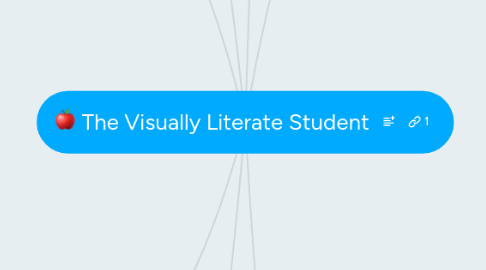
1. IV. Evaluates
1.1. Effectiveness & reliability
1.1.1. Evaluates effectiveness
1.1.2. Assesses appropriateness
1.1.3. Critiques manipulative strategies
1.1.4. Evaluates signs for meaning
1.1.5. Analyzes meaning & editing
1.1.6. Determines accuracy & reliabiligy
1.1.7. Evaluates through criteria
1.2. Aesthetic & technical characteristics
1.2.1. Evaluates aesthetics
1.2.2. Evaluates technical qualities
1.2.3. Evaluates quality of reproduction
1.3. Textual information
1.3.1. Evaluates information
1.3.2. Uses observation
1.3.3. Verifies inforamtion
1.4. Makes judgments on reliability, accuracy
1.4.1. Assesses reliability
1.4.2. Judges quality
1.4.3. Critiques source for context & meaning
2. V. Uses
2.1. Uses images for different purposes
2.1.1. Plans strategically
2.1.2. Selects appropriately
2.1.3. Integrates mindfully
2.1.4. Uses for many purposes
2.2. Uses technology to work with images
2.2.1. Uses appropriate tools for editing, presentation, communication, storage
2.2.2. Determines image file format, size, resolution
2.2.3. Edits as appropriate
2.3. Uses problem solving, creativity, experimentation
2.3.1. Experiments with integrating image & text
2.3.2. Uses visual thinking skills
2.4. Communicates effectively
2.4.1. Writes clearly
2.4.2. Presents effectively
2.4.3. Discusses critically
2.4.4. Includes textual information
2.4.5. Reflects on effectiveness
3. VI. Designs & creates
3.1. Produces for range of projects
3.1.1. Creates images to communicate
3.1.2. Constructs representations of data
3.1.3. Produces images
3.1.4. Aligns visual content with project
3.2. Uses design strategy & creativity
3.2.1. Plans & sets goals
3.2.2. Uses effective communication
3.2.3. Incorporates creativity
3.3. Uses tools & technology to produce images
3.3.1. Experiments with image production
3.3.2. Identifies tools & technology
3.3.3. Develops proficiency
3.4. Evaluates personally created visual products
3.4.1. Evaluates own productions
3.4.2. Reflects on their context
3.4.3. Validates through discourse
3.4.4. Revises based on evaluation
4. VII. Understands
4.1. Understands the ethical, legal, social & economic issues
4.1.1. Develops familiarity with copyright, intellectual property
4.1.2. Develops familiarity with license restrictions
4.1.3. Recognizes own intellectual property rights
4.1.4. Identifies issues of privacy, ethics in sharing images
4.1.5. Explores issues of censorship
4.2. Follows best practises
4.2.1. Identifies institutional policies for image access
4.2.2. Tracks copyright & use restrictions
4.2.3. States rights & attribution
4.3. Creates citations
4.3.1. Gives attribution
4.3.2. Uses citations & credit statements
4.3.3. Uses appropriate citation style
5. I. Determines need
5.1. Defines & articulates
5.1.1. Defines purpose of image
5.1.2. Articulates key criteria
5.1.3. Identifies key concepts & conventions
5.2. Identifies sources
5.2.1. Explores image sources
5.2.2. Investigates scope of image sources
5.2.3. Identifies different media types & materials
5.2.4. Articulates ways images communicate
5.2.5. Recognizes images may be modified & repurposed
6. II. Finds & Accesses
6.1. Selects appropriate sources
6.1.1. Identifies image sources
6.1.2. Articulates pros & cons of image sources
6.1.3. Recognizes image rights & use restrictions
6.1.4. Uses online and in-person services to obtain images
6.1.5. Selects appropriate image source
6.2. Conducts effective searches
6.2.1. Develops search strategy
6.2.2. Recognizes importance of textual information
6.2.3. Identifies keywords, synonyms, related terms for image
6.2.4. Uses images to find other images
6.2.5. Performs image and topical research
6.2.6. Assesses quality, quantity of results
6.3. Acquires & organizes information
6.3.1. Retrieves image using appropriate technologies
6.3.2. Accesses physical objects as needed
6.3.3. Organizes images & their information
7. III. Interprets & Analyzes
7.1. Identifies meaning
7.1.1. Looks carefully
7.1.2. Reads captions, metadata, text
7.1.3. Identifies subject
7.1.4. Examines image relationships
7.1.5. Recognizes the need for information
7.2. Situates culturally, socially, historically
7.2.1. Describes relevant cultural & historical factors
7.2.2. Examines purpose & meaning
7.2.3. Explores choices made in construction of meaning
7.2.4. Describes intended audience
7.2.5. Explores representation
7.2.6. Investigates audience, context, interpretation
7.3. Identifies physical, technical, design components
7.3.1. Describes pictorial, graphic, & aesthetic elements
7.3.2. Identifies techniques, technologies, materials
7.3.3. Determines if original or copy
7.3.4. Examines for editing, alteration, manipulation
7.4. Validates through discourse
7.4.1. Participates in discussion
7.4.2. Seeks expert & scholarly opinion
7.4.3. Informs analysis with perspectives & approaches
